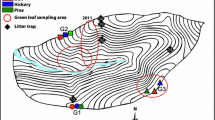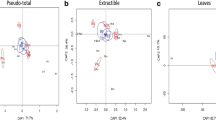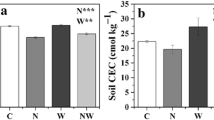Abstract
Baseline levels of 43 elements, including major, trace, and rare earth elements (REEs) in several native plant species growing in boreal and alpine areas, are presented. Focus is placed on species metal levels at different soil conditions, temporal variations in plant tissue metal concentrations, and interspecies variation in metal concentrations. Vegetation samples were collected at Sogndal, a pristine site in western Norway, and at Risdalsheia, an acidified site in southernmost Norway. Metal concentrations in the different species sampled in western Norway are compared with relevant literature data from Norway, Finland, and northwest Russia, assumed to represent natural conditions. Except for aluminium (Al) and macronutrients, the levels of metals were generally lower in western Norway than in southern Norway and may be considered close to natural background levels. In southern Norway, the levels of cadmium (Cd) and lead (Pb) in particular appear to be affected by air pollution, either by direct atmospheric supply or through soil acidification. Levels of some elements show considerable variability between as well as within plant species. Calcium (Ca), magnesium (Mg), and potassium (K) are higher in most species at Sogndal compared to Risdalsheia, despite increased extractable concentrations in surface soil in the south, probably attributed to different buffer mechanisms in surface soil. Antagonism on plant uptake is suggested between Ca, Mg, and K on one hand and Al on the other. Tolerance among calcifuges to acid conditions and a particular ability to detoxify or avoid uptake of Al ions are noticeable for Vaccinium vitis-idaea.




Similar content being viewed by others
References
Allen, R. O., & Steinnes, E. (1986). A contribution to the geochemistry of lakes in Norway. Norges Geologiske Undersøkelse Bulletin, 409, 35–48.
Allen, S. E., Grimshaw, H. M., Parkinson, J. A., & Quarmby, C. (1974). Chemical analysis of ecological materials (p. 565). Oxford: Blackwell Sci. Publ.
Almås, Å. R., Lombnæs, P., Sogn, T. A., & Mulder, J. (2006). Speciation of Cd and Zn in contaminated soils assessed by DGT-DIF, and WHAM/Model VI in relation to uptake by spinach and ryegrass. Chemosphere, 62, 1647–1655.
Amundsen, C. E., Hanssen, J. E., Semb, A., & Steinnes, E. (1992). Long range atmospheric transport of trace elements to southern Norway. Atmospheric Environment, 26A(7), 1309–1324.
Andersson, M. (1988). Toxicity and tolerance of aluminium in vascular plants. A literature review. Water, Air, & Soil Pollution, 39, 439–462.
Berthelsen, B. O., Steinnes, E., Solberg, W., & Jingsen, L. (1995). Heavy metal concentrations in plants in relation to atmospheric heavy metal deposition. Journal of Environmental Quality, 24, 1018–1026.
Bowen, H. J. M. (1979). Environmental chemistry of the elements. London: Academic Press.
Brekken, A., & Steinnes, E. (2004). Seasonal concentrations of cadmium and zinc in native pasture plants: consequences for grazing animals. Science of the Total Environment, 326, 181–195.
Drobner, U., & Tyler, G. (1998). Conditions controlling relative uptake of potassium and rubidium by plants from soils. Plant and Soil, 201, 285–293.
El-Ramady, H.R.H (2008). A contribution on the bio-actions of rare earth elements in the soil/plant environment. Dr. rer. nat. Thesis, Fakultät für Lebenswissenschaften der Technischen Universität Carolo-Wilhelmina zu Braunschweig, Germany.
Fleming, G. A. (1965). Trace elements in plants with particular reference to pasture species. Outlook on Agriculture, 4, 270–285.
Folkeson, L., Nyholm, N. E. I., & Tyler, G. (1990). Influence of acidity and other soil properties on metal concentrations in forest plants and animals. Science of the Total Environment, 96, 211–233.
Garmo, T. H., Frøslie, A., & Høie, R. (1986). Levels of copper, molybdenum, sulphur, zinc, selenium, iron, and manganese in native pasture plants from a mountain area in southern Norway. Acta Agriculturae Scandinavica, 36, 147–161.
Gjengedal, E. (1992). Uptake and mobility of metals in naturally growing plant species in catchments subjected to long-term experimental changes in soil acidification. Dr. scient. Thesis, Department of Chemistry, University of Trondheim, College of Arts and Science, Norway.
Gjengedal, E. (1996). Effects of soil acidification on foliar leaching and retranslocation of metals in vascular plants. Water, Air, & Soil Pollution, 86, 221–234.
Gjengedal, E., & Steinnes, E. (1994). The mobility of metals in soil-plant system in manipulated catchments: plant species suitable for biomonitoring of Cd, Pb, Zn, and Rb. Ecological Engineering, 3, 267–278.
Grønflaten, L. K., & Steinnes, E. (2005). Comparison of four different extraction methods to assess plant availability of some metals in organic forest soil. Communications in Soil Science and Plant Analysis, 36, 2699–2718.
Gustafsson, M. E. R., & Hallgren Larson, E. (2000). Spatial and temporal patterns of chloride deposition in southern Sweden. Water, Air, & Soil Pollution, 124, 345–369.
Hillersøy, M. H. (2010). Plant uptake of barium and strontium in areas with biotite-carbonatite bedrock at Stjernøy, Alta, Norway. Master of Science Thesis, Norwegian University of Life Sciences, Aas, Norway, 102 pp. http://brage.bibsys.no/xmlui/handle/11250/189332. Accessed 22 March 2015.
Hovmand, M. F., Nielsen, S. P., & Johnsen, I. (2009). Root uptake of lead by Norway spruce grown on 210Pb spiked soils. Environmental Pollution, 157, 404–409.
Inc, S. P. S. S. (1988). SPSS-X user’s guide (3rd ed.). NY: Mc Graw-Hill.
Ingestad, T. (1973). Mineral nutrient requirements of Vaccinium vitis-idaea and Vaccinium myrtillus. Physiologia Plantarum, 29, 239–246.
Kabata-Pendias, A. (2011). Trace elements in soils and plants (4th ed.). Boca Raton: CRS Press Inc.
Kålås, J. A. (2003). Environmental monitoring at Tjeldbergodden—monitoring of metal content in terrestrial food chains, 2001–2002. NINA (Norwegian Institute for Nature Research) Oppdragsmelding 796, 22 pp.
Låg, J. (1968). Relationships between the chemical composition of the precipitation and the contents of exchangeable ions in the humus layer of natural soils. Acta Agriculturae Scandinavica, 18, 148–152.
Lid, J. (1979). Norsk og svensk flora. 2. utg. Oslo: Det norske samlaget.
Løbersli, E. M. (1991). Soil acidification and metal uptake in plants. Dr. scient. Thesis, Department of Botany, University of Trondheim, College of Arts and Science, Norway.
Lotse, E., & Otabbong, E. (1985). Physiochemical properties of soils at Risdalsheia and Sogndal: RAIN project. Norwegian Institute for Water Research, Acid Rain Research Report 8/1985, 48 pp.
Martin, M. H., & Coughtrey, P. J. (1982). Biological monitoring of heavy metal pollution. Land and Air. London: Applied Science Publishers.
Martinsen, T. (2008). Innvirkning av redusert forsuring på sporelementer i jord og planter. Master of Science Thesis, Department of Chemistry, Norwegian University of Science and Technology, Norway. 142 pp.
Murach, D. (1984). Die Reaktion der Feinwurzeln von Fichten (Picea abies L. Karst.) auf zunehmende Bodenversauerung. Göttinger Bodenkundl Berichte, 77, 1–127.
NGU (2007). Geochemical mapping of Norwegian bedrock. Geological Survey of Norway. http://www.ngu.no/lito/ (Accessible 29 July 2014).
Nuorteva, P., Autio, S., Lehtonen, J., Lepistö, A., Ojala, S., Seppänen, A., Tulisalo, E., Veide, P., Viipuri, J., & Willamo, R. (1986). Levels of iron, aluminium, zinc, cadmium, and mercury in plants growing in the surroundings of an acidified and a non-acidified lake in Espoo, Finland. Annales Botanici Fennici, 23, 333–340.
Nygård, T., Steinnes, E., & Røyset, O. (2011). Distribution of 32 elements in organic surface soils: contributions from atmospheric transport of pollutants and natural sources. Water, Air, and Soil Pollution, 223, 699–713.
Overrein, L. N., Seip, H. M., & Tollan, A. (1980). Acid precipitation—effects on forest and fish. Report FR 19/80, SNSF-project, Ås, Norway, 175 pp.
Peijnenburg, W. J. G. M., & Jager, T. (2003). Monitoring approaches to assess bioaccessibility and bioavailability of metals: matrix issues. Ecotoxicology and Environmental Safety, 56, 63–77.
Reimann, C., Koller, F., Kashulina, G., Niskavaara, H., & Englmaier, P. (2001). Influence of extreme pollution on the inorganic chemical composition of some plants. Environmental Pollution, 115, 239–252.
Sandvik, A., Steinnes, E., & Rivedal, S. (2005). Contents of some essential trace elements in grass from cultivated meadows and vegetation from natural pastures in western Norway: is there an adequate supply to sheep? Essential trace elements for plants, animals and humans. NFJ Seminar no. 370, Reykjavik, Iceland, 15-17 August 2005, p. 57-60.
Särkelä, M., & Nuorteva, P. (1987). Levels of aluminium, iron, zinc, cadmium and mercury in some indicator plants growing in unpolluted Finnish Lapland. Annales Botanici Fennici, 24, 301–305.
Sivertsen, T., Garmo, T. H., Lierhagen, S., Bernhoft, A., & Steinnes, E. (2014a). Geographical and botanical variation in concentrations of copper, molybdenum, sulphur and iron in sheep pasture plants in Norway. Acta Agriculturae Scandinavica Section A, 64(3), 178–187. doi:10.1080/09064702.2014.1001871.
Sivertsen, T., Garmo, T. H., Lierhagen, S., Bernhoft, A., & Steinnes, E. (2014b). Geographical and botanical variation in concentrations of selenium, cobalt, iodine, zinc and other essential elements in sheep pasture plants in Norway. Acta Agriculturae Scandinavica Section A, 64(3), 188–197. doi:10.1080/09064702.2014.1001872.
Steinnes, E., Solberg, W., Petersen, H. M., & Wren, C. D. (1989). Heavy metal pollution by long range atmospheric transport in natural soils of southern Norway. Water, Air, & Soil Pollution, 45, 207–218.
Steinnes, E., Allen, R. O., Petersen, H. M., Rambæk, J. P., & Varskog, P. (1997a). Evidence of large-scale heavy-metal contamination of natural surface soils in Norway from long-range atmospheric transport. Science of the Total Environment, 205, 255–266.
Steinnes, E., Rühling, Å., Lippo, H., & Mäkinen, A. (1997b). Reference materials for large-scale metal deposition surveys. Accreditation and Quality Assurance, 2, 243–249.
Steinnes, E., Berg, T., & Uggerud, H. T. (2011). Three decades of atmospheric metal deposition in Norway as evident from analysis of moss samples. Science of the Total Environment, 412–413, 351–358.
Ström, L., Olsson, T., & Tyler, G. (1994). Differences between calcifuge and acidifuge plants in root exudation of low-molecular organic acids. Plant and Soil, 167, 239–245.
Tukey, H. B., Jr. (1970). The leaching of substances from plants. Annual Review of Plant Physiology, 21, 305–324.
Tukey, H. B., Jr., Tukey, H. B., & Wittwer, S. H. (1958). Loss of nutrients by foliar leaching as determined by radioisotopes. Journal Proceedings of the American Society for Horticultural Science, 71, 496–506.
Tyler, G. (1983). Rubidium—availability and plant uptake in natural soils. Communications in Soil Science and Plant Analysis, 14, 1075–1089.
Tyler, G. (1997). Influence of acidity and potassium saturation on plant uptake of indigenous soil rubidium. Environmental and Experimental Botany, 38, 181–186.
Tyler, G. (2003). Some ecophysiological and historical approaches to species richness and calcicole/calcifuge behaviour—contribution to a debate. Folia Geobotanica, 38, 419–428.
Tyler, G. (2004). Rare earth elements in soil and plant systems—a review. Plant and Soil, 267, 191–206.
Wright, R. F. (1991). RAIN project. Report for the years 1988, 1989, and 1990. Norwegian Institute for Water Research, Acid Rain Research Report 24/1991, 156 pp.
Wright, R. F., Gjessing, E., Christophersen, N., Lotse, E., Seip, H. M., Semb, A., Sletaune, B., Storhaug, R., & Wedum, K. (1986). Project RAIN: changing acid deposition to whole catchments. The first year of treatment. Water, Air, & Soil Pollution, 30, 47–63.
Wright, R. F., Lotse, E., & Semb, A. (1988). Reversibility of acidification shown by whole-catchment experiments. Nature, 334, 670–675.
Wright, R. F., Lotse, E., & Semb, A. (1993). RAIN project—results after 8 years of experimentally reduced acid deposition to a whole catchment. Canadian Journal of Fisheries and Aquatic Sciences, 50(2), 258–268.
Wright, R. F., Lotse, E., & Semb, A. (1994). Experimental acidification of alpine catchments at Sogndal, Norway—results after 8 years. Water, Air, & Soil Pollution, 72, 297–315.
Wyttenbach, A., & Tobler, L. (2002). Soil contamination in plant samples and in botanical reference materials: signature, quantification and consequences. Journal of Radioanalytical and Nuclear Chemistry, 254(1), 165–174.
Zhang, H., Zhao, F. J., Sun, B., Davison, W., & McGrath, S. P. (2001). A new method to measure effective soil solution concentration predicts copper availability to plants. Environmental Science and Technology, 34, 2602–2607.
Zhang, H., Lombi, E., Smolders, E., & McGrath, S. (2004). Kinetics of Zn release in soils and prediction of Zn concentration in plants using diffusive gradients in thin films. Environmental Science and Technology, 38, 3608–3613.
Author information
Authors and Affiliations
Corresponding author
Rights and permissions
About this article
Cite this article
Gjengedal, E., Martinsen, T. & Steinnes, E. Background levels of some major, trace, and rare earth elements in indigenous plant species growing in Norway and the influence of soil acidification, soil parent material, and seasonal variation on these levels. Environ Monit Assess 187, 386 (2015). https://doi.org/10.1007/s10661-015-4479-5
Received:
Accepted:
Published:
DOI: https://doi.org/10.1007/s10661-015-4479-5




